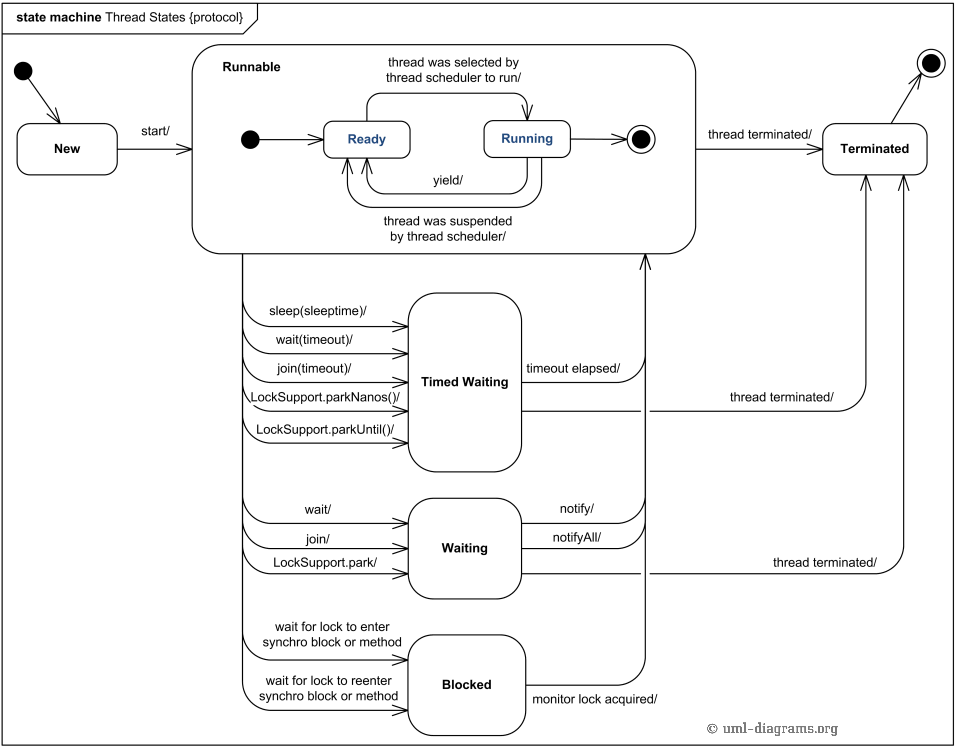*Threads. * Thread is also known as lightweight process. Java multithreading allows to process multiple task simultaneously with less overhead than process. Mostly use to monitor session, background synchronization etc.
Content
Processes : These are often application or programs running in their own memory space and runtime resources. In simple term when you run new program with main() method . It is basically a new process and have their own private memory, and resources.
Thread: The path of execution of a process is known as Thread. A process can have more than one thread. In a simple program with main() method.This program contains a user defined thread with main() method. While with user threads there are system threads like memory management and signal handling.
- Threads are also known as lightweight processes.
- A process must contain at least one Thread.
- All threads inside a process can communicate each other via shared memory space (Shared variable)
Creating first Java Thread There are two way to create java threads.
-
- In both cases we need to override run() method and this method is part of a thread. A thread start from start from starting of run() and ends when run() ends.
- To start thread, Thread object needs to be start using *threadObj.start()* which invoke the thread and execute the run method.
- Implementing Runnable interface :
public class ThreadExtendingRunnable {
public static void main(String []args){
MyThread1 obj1 = new MyThread1("thread1");
MyThread1 obj2 = new MyThread1("thread2");
Thread t1 = new Thread(obj1);
Thread t2 = new Thread(obj2); // you can pass the same object. It allows you to associate single object to multiple threads
t1.start();
t2.start();
}
}
class MyThread1 implements Runnable {
String str;
MyThread1(String str){
this.str = str;
}
@Override
public void run() {
for(int i=0; i<=5; i++){
System.out.println(str+" " + i);
}
}
}
2.
Extending
*Thread class *public class MyThreadExtendingThread {
public static void main (String []args){
MyThread2 t1 = new MyThread2("thread1") ;
MyThread2 t2 = new MyThread2("thread2") ;
t1.start();
t2.start();
}
}
class MyThread2 extends Thread{
String str;
MyThread2(String str){
this.str = str;
}
public void run(){
for(int i=0; i<=5; i++){
System.out.println(str+" " + i);
}
}
}
Implementing *Runnable* vs Extending *Thread*
:
Implementing Runnable allows you to extends another class while, if you extend Thread class you will not able to extends any other class.
- Extending thread, each thread needs to associate with unique object.
- Implementing Runnable allows you to associate single object to as many threads you want.
- Sharing same object to multiple thread also avoids unnecessary object creation and saves memory.
Thread State and Life Cycle
 Source: uml-diagram.org
Source: uml-diagram.org
A thread can be one of the following state (java 1.5+)
-
NEW
: A thread has not started yet. -
RUNNABLE
: Thread is running state but it can be in state of waiting. -
BLOCKED
: Thread is waiting to acquire monitor lock to enter into a synchronized block/method after calling Object.wait() -
WAITING
: A thread is in waiting state due to calling one of the following methods-
Object.wait()
: It causes current thread to wait until it been notified by method notify() or notifyAll(). -
Object.join()
: Waits for current thread to die. -
LockSupport.park
: Disables the current thread for thread scheduling purposes unless the permit is available.
-
-
TIMED_WAITING
: Current thread is waits for another thread for specified time to perform the aciton.-
Thread.sleep (long timeInMilliSecond)
: Makes current thread to cease the execution for specified time. -
Object.wait (long timeInMilliSecond)
: Causes current thread to wait for specified time until time elapsed or get notified by notify() or notifyAll(). -
Thread.join (long millis)
: Current thread waits for specified time to die the thread. -
LockSupport.parkNanos (long nanoSeconds)
: Disables the current thread for thread scheduling purposes, for up to the specified waiting time, unless the permit is available. LockSupport.parkUntil ()
-
TERMINATED
: When thread completed its execution.
\<Post in progress to explain thread states>
Daemon Thread Daemon threads are threads to which JVM don't watch to completed or not. So how JVM works, As soon as all user threads finished processing , JVM terminated itself. JVM doesn't wait to finish daemon threads. Garbage collector and other housekeeping threads are inbuild daemon threads.
- User created threads are non-daemon by default, since it's created by main() thread which is by default a non-daemon and newly created thread inherit daemon property from the thread it was created.
- To set a user created thread as daemon, you need to set by
Thread.setDaemon(true)
(Make sure you set a daemon before callingstart()
).
Example: Daemon Thread
public class DaemonTest {
public static void main(String []args){
DaemonObject deamonObj = new DaemonObject(1000, "daemonThread");
DaemonObject notDaemonObj = new DaemonObject(500, "notDaemonThread");
Thread t1 = new Thread(deamonObj);
Thread t2 = new Thread(notDaemonObj);
t1.setDaemon(true);
t1.start();
t2.start();
}
}
class DaemonObject implements Runnable{
int sleepTime;
String threadname;
DaemonObject(int sleepTime, String threadname){
this.sleepTime = sleepTime;
this.threadname = threadname;
}
@Override
public void run() {
for(int i=0; i < 5; i++){
System.out.println(threadname+ " " + i);
try {
Thread.sleep(sleepTime);
} catch (InterruptedException e) {
e.printStackTrace();
}
}
}
}
----------
Output will be like:
----------
daemonThread 0
notDaemonThread 0
notDaemonThread 1
daemonThread 1
notDaemonThread 2
notDaemonThread 3
daemonThread 2
notDaemonThread 4
Process finished with exit code 0
Notice, thread marked as daemon thread didn't completed its execution, because JVM only waited for non-daemon thread and as soon as it completed, JVM also terminated.
